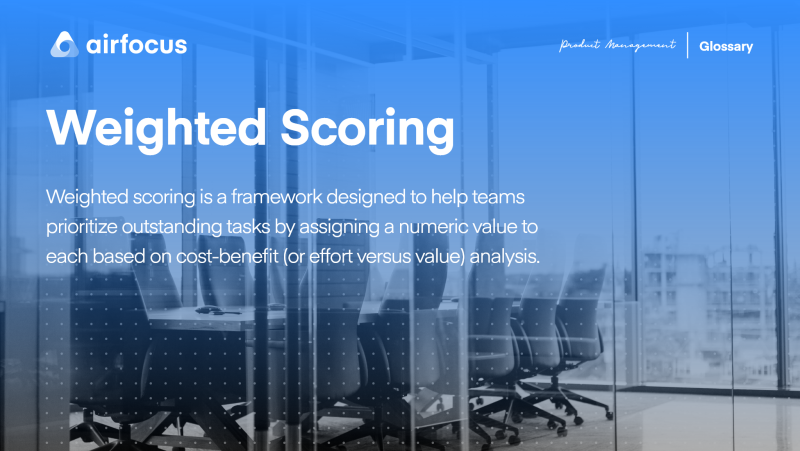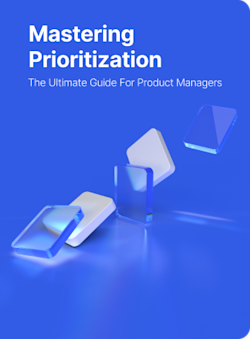Weighted Scoring
What is weighted scoring?
Definition of weighted scoring
Weighted scoring is a framework designed to help teams prioritize outstanding tasks by assigning a numeric value to each based on cost-benefit (or effort versus value) analysis.
Making decisions is never easy, especially when there’s a big team involved. And with product development, big teams are almost always par for the course.
So how can product teams prioritize their roadmap and make smart, data-driven decisions about what they should do first?
Here’s where the weighted scoring prioritization framework comes in handy.
This tool exists to solve the conundrum of group decision-making and roadmap prioritization — doing so in a way that is both objective and fair.
Download Now: Get our eBook on Mastering Prioritization
Because the framework is based on a cost-benefit analysis of criteria that matter most to the project, final priorities are well-reasoned by design.
How the weighted scoring framework works
The best way to understand how weighted scoring works is to consider the two parts of the term: weighting and scoring.
Let’s look at both in more detail, but, for reasons that will make sense in just a moment, let’s start with the latter.
The scoring half of the framework refers to the idea that all the outstanding tasks must be assigned a value based on their importance.
The weighting half of the framework is the criteria by which this scoring is achieved — and it’s where things really get interesting. Before the framework can be applied to any scenario, the team must first decide on a set of criteria using a cost-benefit analysis and assign values to each of them.
Once values have been assigned, a simple formula is used to compare the cost of a task to its benefits and calculate the overall score for each task.
From there, it’s a simple matter of sorting by total score, and voila, you have a prioritized list of tasks weighted by the things that mean most to the business.
How to use the weighted scoring framework in product development
There’s no doubt that weighted scoring can be a complex topic to get your head around, so let’s look at this in more practical terms.
How do you actually use weighted scoring in the context of product development? Below we’ll go through each of the steps one by one, and explain what your team needs to do in order to best use the framework.
1. The first step is to list all of your outstanding tasks. In the context of product development, these could be:
Create mobile version
Update UX to match new branding
Update and upload sitemap
2. Now you’ll want to choose the criteria that will influence your weighting, broken down into costs and benefits. Costs can include things "like development time and resource", and benefits may include “revenue increase”. Take the time to list an equal number of costs and benefit criteria that can be applied to your task list.
3. The next step is to assign weights to each of your criteria. This is usually done with 100 as the maximum weighting. For example, a revenue increase might carry a weight of 75, whereas development time might carry a weight of 50.
4. At this point, you should have a matrix with all of your tasks in the left column and all of your criteria along the top, broken down into costs and benefits, with a numeric weighting value assigned to each one. From here, it’s a simple matter of assigning a number (usually from 1 to 5) to each of your tasks, based on how it’s impacted by your criteria. For example, you might assign the development of a mobile version with a “revenue increase” value of 5 (because it’s very important to you), and the “development time and resource” a value of 2 (because you’re willing to invest).
5. Once you’ve assigned a score to each of your tasks for each relative criteria, you’ll be able to start adding up the totals. Multiply the value you assigned in the last step by the 1-100 criteria value and add up each column. All that’s left to do then is subtract the total costs from the total benefits.
Once you’re done crunching numbers, you’ll be left with a single numeric value for each task which represents the weighted score for that task.
From there, it’s a simple matter of sorting your backlog by that weighted score. Simple!
The benefits of weighted scoring for product teams
Now that you know how to apply the weighted scoring framework to a product development backlog, let’s consider why you might want to do so.
Whether you’re a product owner, product manager, or another key stakeholder in the development team, you’ll already know the value of a well-prioritized backlog, but there are plenty of other reasons to apply weighted scoring to your outstanding tasks.
Here are just a few:
Ensure that all tasks on the product roadmap offer true value to the company, even when set against the potential costs.
Reduce friction between team members when making group decisions.
Because of the cost-benefit weighting, the model guarantees that tasks are completed in an order which is in alignment with the company’s goals and overall strategy.
Remove the reliance on manual processes during backlog refinement, speeding up the prioritization process, and improving development efficiency.
Over time, weighted scoring reveals which tasks (or features) are consistent with low value, giving the product owner the chance to prune the backlog with the little-to-no argument from the team.

General FAQ

Glossary categories
Prioritize with confidence

Experience the new way of doing product management








